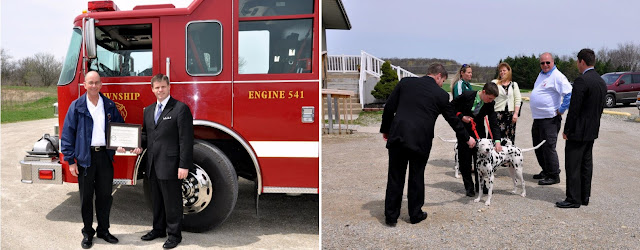In 2009, the Citizens Against CO2 Sequestration organized to stop a carbon dioxide sequestration project proposed for Greenville’s Industrial Park. Soon that group grew to encompass thousands of citizens throughout the county who were willing to stand up and speak out for their rights.
It was because of their numbers that the project was stopped - - a project which not only threatened the lives and livelihoods of many Darke County residents but also the area’s soil and sole-source aquifer in one of the leading agricultural counties in the State.
Hoping they will be as successful in the present as they were in the past, the group has reorganized with a new name and a new goal. Now known as the
Western Ohio Fracking Awareness Coalition, they want folks to be aware that a Class II Injection Disposal Well might be located in southwestern Ohio, and they want to stop it.
There are two kinds of wells associated with fracking - - One produces the gas and the other injects the waste. Southwestern Ohio is targeted for the waste.
As folks in southwestern Ohio hear about fracking and the natural gas boom in eastern Ohio, they remain unaware that east could meet west when they too will experience the trickle down effects from the boom.
However, the Coalition says it won’t be from royalty fees, jobs, and a growing economy. Instead, it will be from liquid brine mixed with toxic chemicals and radioactive waste coming from Horizontal Hydraulic Fracking wells in the Marcellus shale.
How toxic is toxic? Joe Logan, Director of Agricultural Programs for the Ohio Environmental Council, said that over 600 chemicals are used during the fracking process. These chemicals are disposed along with the brine.
Logan, who is backed up by doctors and public health officials, says that many of these chemicals can cause cancer, birth defects, reproductive, respiratory, and blood disorders as well as central nervous system and neurological problems.
How radioactive is radioactive? In a December 2011 study, Mark Engle, a U.S. Geological Survey Research Geologist, found that brine collected from the Marcellus shale was 3,609 times more radioactive than the federal safety limit for drinking water and 300 times higher than a Nuclear Regulatory Commission limit for industrial discharges to water.
This brine, which is the waste left over from Hydraulic Horizontal Fracking Wells, must go somewhere, and that somewhere is into Class II Injection Disposal Wells, which have been designated only for waste from the gas and oil industry.
Is Ohio Becoming the Dumping Ground for Out-of-State Waste?
Ohio has 179 injection disposal wells, which not only take brine from Ohio but from other states as well. Because of the natural gas boom which is spreading throughout the country, the Ohio Department of Natural Resources reports the volume injected into Ohio wells is at a record level with more than half of the waste coming from out of state.
As more fracking wells are projected to be permitted in eastern Ohio, Pennsylvania, and other states which contain the Marcellus shale, more injection disposal wells are needed. However, the real question is, “Are they wanted?”
The Mount Simon Sandstone Formation is Considered the Most Likely Site for Injection Disposal Wells
Limited to western Ohio (including Darke County) and the adjacent proto Michigan-Illinois basin, the Mt. Simon Sandstone extends north of western Lake Erie and southward to the northwestern Rome Trough fault system. Mark T. Baranoski, who was a geologist with the Ohio Division of Geological Survey Services in Columbus, mapped this formation during an intensive study he had conducted in 2007.
This is the formation that Battelle and the National Energy Technology Laboratory thought would safely sequester CO2 in Greenville’s Industrial Park.
This is the formation that runs beneath the area’s sole source aquifer, which is part of the Great Miami Valley Aquifer.
This is the formation that also contains a deep saltwater reservoir beneath the freshwater aquifers. Scientists and water conservancy officials warn that saltwater, along with fracking contaminants, could be displaced into wells and groundwater from the high pressure needed to inject the waste from fracking.
This is the formation that Julie Weatherington-Rice, adjunct professor at the Ohio State University and Senior Scientist at Bennett Environmental Services, warned would be the most likely site in Ohio to attract injection wells for the disposal of waste from fracking wells.
She said it is not only thought to have the geology needed to contain the waste, but it is shallower in southwestern Ohio than it is in other areas of the formation. “The shallower the drill site the less expensive it is for the driller,” she emphasized.
Class II Injection Disposal Wells Can Cause Injection Induced Earthquakes
There was a whole lot of shaking going on when an earthquake rattled Youngstown, which had never experienced so much as a tremor. Eleven more quakes were to follow before the Ohio Department of Natural Resources determined they were caused by an injection disposal well - - a well that had been drilled too deep under too much pressure into a fault in the Precambrian basin. It was Ohio’s wake-up call that injection induced earthquakes CAN and DO happen.
Truck Traffic, Road Damage and Spills
Technical Reports show that injection wells operate 24-7, ushering in heavy trucks and heavier costs for cities, counties and townships. Asphalt isn’t cheap and limited liability drilling companies don’t willingly share costs - - particularly when it comes to cleaning up spills and the contamination of soil and water.
Darke County Engineer Jim Surber summed it up when he said, “I would much rather have CO2 beneath me than fracking waste, but I definitely wouldn’t want either of them.”
For more information about fracking and disposal wells go to the Western Ohio Fracking Awareness Coalition’s website at
http://www.wofac.org/

































